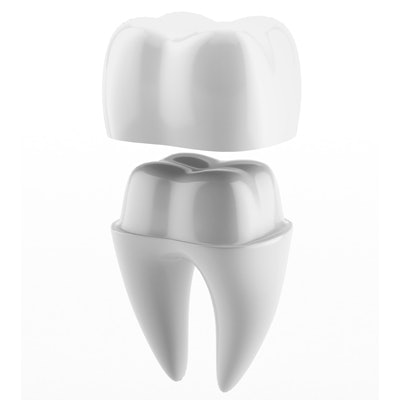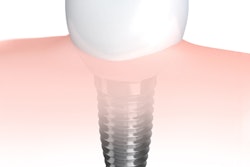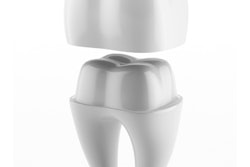
The need for a stronger material for prosthetics led to the development of zirconia for crowns and fixed prosthetics. But how does this material hold up in wear and fracture tests? Researchers subjected two different monolithic zirconia materials to in vitro tests to find out.
They subjected BruxZir (Glidewell Laboratories) and inCoris TZI (Dentsply Sirona) to more than 1 million chewing cycles to measure wear and fracture resistance. They reported that the BruxZir material was more resistant to fracture than inCoris TZI in a study published in BMC Oral Health (August 23, 2018).
"The fracture strengths of BruxZir crowns and [fixed dental prostheses] were found to be greater than those of their counterparts fabricated with inCoris TZI," wrote the authors, led by Işıl Sarıkaya, PhD, of the department of prosthodontics at the Tokat Gaziosmanpaşa University Faculty of Dentistry in Tokat, Turkey.
Loading cycles
Developments in CAD/CAM technology have increased the diversity of materials that can be used for restorations. High-strength restorative materials for crowns or partial fixed dental prostheses should be resistant to wear and fracture, especially in the mouth's posterior region. This has to be balanced with the need for the material not to cause temporomandibular joint disorders or increase the degree of dysfunction. As zirconia restorations were developed with the aim of providing a stronger material for prosthetic dentistry, the researchers wanted to measure the wear and fracture strength of two monolithic zirconia materials.
They conducted an in vitro test by fabricating 16 crowns and the same number of three-unit fixed dental prostheses using BruxZir and inCoris TZI materials (eight each). The team subjected the specimens to a two-body wear test in a dual-axis chewing simulator for 1.2 million loading cycles against steatite antagonist balls and recorded fracture strength and volumetric loss.
The mean volumetric loss of the crowns was higher than that of the three-unit prostheses (p < 0.05), the researchers reported. Of the two monolithic systems, inCoris TZI exhibited more wear than BruxZir (see table below).
| BruxZir vs. inCoris TZI for mean volumetric loss (mm3) | ||
| BruxZir | inCoris TZI | |
| Crowns | 1.43 mm3 ± 0.12 | 1.55 mm3 ± 0.11 |
| Fixed prostheses | 1.15 mm3 ± 0.17 | 1.37 mm3 ± 0.16 |
| Total | 1.29 mm3 ± 0.21 | 1.46 mm3 ± 0.16 |
While none of the samples fractured during the testing process, the fracture strengths of BruxZir crowns and fixed prostheses were higher than those of the crowns and prostheses fabricated with inCoris TZI (p < 0.05) (see table below).
| BruxZir vs. inCoris TZI for mean fracture load (newtons) | ||
| BruxZir | inCoris TZI | |
| Crowns | 4,495.00 ± 221.33 | 3,566.50 ± 217.24 |
| Fixed prostheses | 4,507.25 ± 166.44 | 3,327.13 ± 185.81 |
| Total | 4,501.13 ± 189.29 | 3,446.81 ± 231.12 |
In these tests, both materials were fracture-resistant for the crown and fixed prosthesis application against physiologic chewing forces owing to dynamic aging, the researchers concluded.
Bruxism issues
The authors listed two study limitations: the difficulty of determining the ideal chewing cycle and the lack of a secondary higher force against BruxZir.
As the BruxZir material was originally produced to act against bruxism, it would have exhibited more strength than 49 newtons used in their study, they noted. This force was used as it is considered the normal chewing force in the posterior region, they added. The authors recommended that further studies be undertaken that consider chewing forces specific for patients with bruxism.
The researchers concluded that both materials were fracture-resistant.
"BruxZir and inCoris TZI monolithic zirconia systems were found to be fracture-resistant for crowns and [fixed dental prostheses] against physiologic chewing forces owing to dynamic aging in vitro test conditions," they wrote.



















